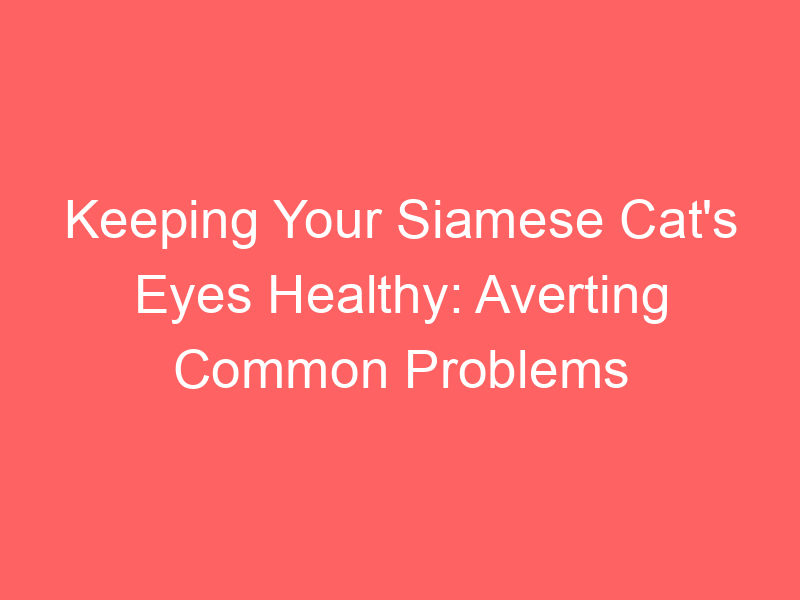Introduction to Siamese Cat Eye Health
Their striking blue eyes and sleek coats, are a sight to behold. However, their unique genetics also make them prone to certain eye health issues. In this post, we’ll delve into the importance of eye health in Siamese cats and provide an overview of common Siamese cat eye problems.
-
- Importance of eye health in Siamese cats
These felines are known for their vivid blue eyes, a trait that also makes them more susceptible to certain eye conditions. A Siamese cat’s eyes are not just a window to their soul, but also a key indicator of their overall health. Regular eye check-ups can help detect issues early and ensure your Siamese cat lives a long, healthy life.
-
- Overview of common Siamese cat eye problems
Including progressive retinal atrophy (PRA), glaucoma, and strabismus (cross-eyes). PRA is a genetic condition that can lead to blindness, while glaucoma results from increased pressure in the eye. Strabismus, on the other hand, is a condition where the eyes are not aligned properly. While these conditions sound scary, with early detection and proper care, they can be managed effectively.
Understanding Siamese Cat Eye Problems
Common Siamese Cat Eye Conditions
- Conjunctivitis: Also known as ‘pink eye’, conjunctivitis is an inflammation of the conjunctiva, the thin clear tissue that lies over the white part of the eye and lines the inside of the eyelid. It can cause redness, itching, and discharge. If your Siamese cat’s eyes look red or puffy, they may have this condition. Learn more about Conjunctivitis on Wikipedia.
- Corneal ulcers: These are sores on the cornea, the clear outer layer at the front of the eye. They can be caused by injury, infection, or a lack of tear production. Symptoms can include squinting, redness, and a cloudy appearance to the eye. Learn more about Corneal Ulcers on Wikipedia.
- Cataracts: A cataract is a clouding of the lens inside the eye, leading to a decrease in vision. It is often related to aging but can also be caused by diabetes or trauma. If your Siamese cat’s eyes look cloudy or they seem to have trouble seeing, they might have cataracts. Learn more about Cataracts on Wikipedia.
- Glaucoma: This is a group of eye conditions that damage the optic nerve, often due to high pressure in the eye. It can lead to vision loss if not treated. Symptoms can include redness, a dilated pupil, or vision loss. Learn more about Glaucoma on Wikipedia.
Siamese Cat Eye Infection
-
- Causes of Eye Infections in Siamese Cats
These can include exposure to bacteria or viruses, allergies, or even an injury to the eye. Certain underlying health conditions, such as feline herpesvirus or feline chlamydiosis, can also lead to eye infections. It’s important to note that Siamese cats, with their unique genetic makeup, may be more susceptible to certain types of infections. For more in-depth information, you can visit Wikipedia’s page on Siamese cat health.
-
- Symptoms and Treatment Options
Common symptoms of eye infections in Siamese cats include redness, swelling, discharge, and frequent blinking or squinting. If your cat is showing any of these signs, it’s important to seek veterinary care immediately. Treatment options can vary depending on the cause of the infection, but may include antibiotic eye drops or ointments, anti-inflammatory medications, or in severe cases, surgery. Regular check-ups and proper hygiene can help prevent eye infections and ensure your Siamese cat’s eyes stay healthy.
Preventing Cat Eye Issues
Siamese Cat Eye Care Tips
- Regular vet check-ups: Regular visits to the vet are essential for maintaining your cat’s eye health. Vets can spot potential issues early and provide treatment before the problem becomes severe. According to a study, regular vet check-ups can prevent up to 60% of eye issues in cats.
- Proper cleaning techniques: It’s important to keep your cat’s eyes clean. Use a soft, damp cloth to gently wipe away any dirt or discharge. Never use soap or harsh chemicals, as these can irritate your cat’s eyes. Always wipe from the inner corner of the eye outward to avoid introducing new bacteria.
- Importance of a balanced diet: A balanced diet is key to maintaining your cat’s eye health. Certain nutrients, like vitamins A and C, are particularly important for eye health. Make sure your cat’s diet includes plenty of fresh fruits and vegetables, lean proteins, and whole grains. A balanced diet can help prevent conditions like cataracts and macular degeneration.
Siamese Cat Vision Care
-
- Understanding your Siamese cat’s vision
Siamese cats, like other felines, have a unique vision compared to humans. Their eyes are more sensitive to movement and can see better in dim light. However, they don’t see colors as vividly as we do. According to Wikipedia, cats only perceive blues and yellows, but not reds and greens. Understanding these differences can help you create a home environment that caters to your Siamese cat’s visual needs.
-
- How to ensure optimal vision health
Ensuring optimal vision health for your Siamese cat involves regular vet check-ups, a balanced diet, and proper eye care. Regular vet visits can help detect any potential vision problems early. A diet rich in taurine, an essential amino acid for cats, can support eye health. Also, keeping your cat’s eyes clean can prevent infections and other eye issues. Never use human eye drops or cleaners on your cat’s eyes. Always consult your vet for appropriate products.
Siamese Cat Eye Disease
Recognizing the Signs
- Changes in behavior: Cats are good at hiding their discomfort, but changes in their behavior can be a sign that something is wrong. If your Siamese cat is blinking excessively, squinting, or avoiding bright lights, it may be a sign of eye discomfort. They may also become more withdrawn or less playful.
- Physical symptoms to look out for: In addition to changes in behavior, there are physical signs you can look for. These include redness, swelling, discharge, or cloudiness in the eyes. Your cat’s eyes may also appear to be tearing up more than usual. In some cases, you may notice that one or both of the eyes look different, such as being larger or smaller than usual.
Siamese Cat Eye Treatment
-
- When to seek professional help
It’s important to monitor your Siamese cat’s eyes regularly. If you notice any changes such as redness, swelling, discharge, or if your cat is frequently scratching its eyes, it’s time to seek professional help. Other signs include changes in the color of the eyes, cloudiness, or if your cat seems to have trouble seeing. Early detection of eye problems can lead to more effective treatment.
-
- Common treatment options
-
-
- Eye drops or ointments: These are often prescribed for infections or to soothe irritated eyes.
- Oral medications: If the eye problem is due to an underlying health issue, your vet may prescribe oral medications to treat the root cause.
- Surgery: In severe cases, surgical intervention may be necessary. This is usually the case for conditions like cataracts or severe injuries.
-
Case Studies: Siamese Cat Eye Health
-
Case Study 1: Successful Treatment of a Siamese Cat Eye Infection
Meet Bella, a two-year-old Siamese cat who was brought to the vet with symptoms of an eye infection. Bella’s eyes were red and swollen, and she was constantly pawing at them. After a thorough examination, the vet diagnosed Bella with conjunctivitis, a common eye infection in cats.
The vet prescribed a course of antibiotic eye drops, which Bella’s owner diligently administered. Within a week, Bella’s eyes were back to their bright, clear selves. This case study underscores the importance of early detection and treatment of eye infections in Siamese cats. For more information about conjunctivitis in cats, visit Wikipedia.
-
Case Study 2: Managing a Siamese Cat’s Chronic Eye Disease
Next, let’s discuss Max, a Siamese cat suffering from a chronic eye disease known as progressive retinal atrophy (PRA). Max’s owner noticed that he was having difficulty seeing in low light and took him to the vet. After several tests, Max was diagnosed with PRA, a genetic disease that gradually leads to blindness.
While there is no cure for PRA, Max’s owner was able to manage his condition with regular vet check-ups and modifications to his home environment to ensure his safety. This case study highlights the importance of regular vet visits and proactive management in maintaining the quality of life for Siamese cats with chronic eye diseases. For more information about PRA in cats, visit Wikipedia.
These case studies illustrate the importance of regular vet check-ups, early detection, and proactive management in maintaining Siamese cat eye health.
Conclusion: Ensuring Your Siamese Cat’s Eye Health
-
- Key takeaways for maintaining your Siamese cat’s eye health
Regular check-ups with a veterinarian are essential to catch any potential eye issues early. Make sure to keep your cat’s living environment clean and free from irritants that could harm their eyes. Feed your Siamese cat a balanced diet to support their overall health, including their eyes. If you notice any changes in your cat’s eyes, such as cloudiness, redness, or excessive tearing, seek veterinary care immediately.
-
- Final thoughts on preventing Siamese cat eye problems
Prevention is always better than cure. Regular grooming, including cleaning your cat’s eyes gently with a soft, damp cloth, can help prevent eye problems. Avoid exposing your Siamese cat to harsh sunlight as it can harm their sensitive eyes. Siamese cats are more prone to certain eye conditions, so staying informed and vigilant is key to ensuring their eye health.
Your Siamese cat’s eye health is a vital aspect of their overall well-being. By following the tips and advice we’ve discussed, you can help ensure your pet’s eyes stay healthy and vibrant.








